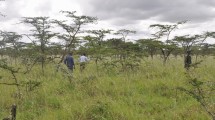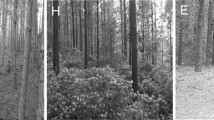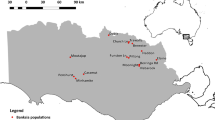Summary
Some perennial fugitive plants that colonize badger disturbances in xeric prairies have a limited dispersal capacity, and consequently propagules are dispersed over a small area. I hypothesized that high density-dependent mortality might occur early in the life history of such species, and thus increased survival might occur in subsequent age classes because intraspecific competition would be reduced. These hypotheses were tested using natural and experimental cohorts of Mirabilis hirsuta (Pursh) MacM. From these data and field observations, inferences were obtained concerning selective forces operating upon life history characteristics of this species.
The distance between individuals of M. hirsuta increases in successive age classes; the greatest decrease in density occurs between the propagule and seedling age classes. Mortality of propagules due to predation by ants and mice was density-dependent. Predation rates were highest at high propagule densities and predation upon propagules located on badger disturbances was higher than the mortality of propagules at similar densities in undisturbed prairie. The results of mortality in the propagule age class are seedlings present only at low densities and located away from parent plants. Seedlings survive to maturity only if they are located on badger disturbances; this species apparently can not successfully compete with plants present in undistrubed prairie. On badger disturbances seedlings present at low densities have much higher survival (roughly 50%) to maturity than do seedlings present at high densities (essentially zero). Thus, if high densities of propagules occur on a disturbance, predation upon propagules results, indirectly, in increased survival of seedlings to maturity. Such predation potentially could have important effects upon interspecific competition of M. hirsuta with other fugitives also colonizing badger disturbances.
Reproductive success of M. hirsuta on the Cayler Prairie Preserve is contingent upon successful colonization of disturbance sites. It would appear that selection has operated upon the life history characteristics to favor both successful immigration onto new sites and establishment of seedlings on those sites. Relatively few, but large propagules are produced annually over a long adult life span. While large propagules enhance seedling establishment on xeric sites, production of few propagules annually for a number of years increases the likelihood of immigration onto sites that are variable in the time of appearance within the dispersal range of the plant.
Similar content being viewed by others
References
Baker, H. G.: Seed weight in relation to environmental conditions in California. Ecology 53, 997–1010 (1972)
Bartholomew, B.: Bare zone between California shrub and grassland communities: the role of animals. Science 170, 1210–1212 (1970)
Berg, R. Y.: Dispersal ecology of Vancouveria (Berberidaceae). Amer. J. Bot. 59, 109–122 (1972)
Carroll, C. R., Janzen, D. H.: Ecology of foraging by ants. Annu. Rev. Ecol. Syst. 4, 231–257 (1973)
Cook, A. D., Atsatt, P. R., Simon, C. A.: Doves and dove weed: multiple defenses against avian predation. Bioscience 21, 277–281 (1971)
Cruden, R. W.: Reproductive biology of weedy and cultivated Mirabilis (Nyctaginaceae). Amer. J. Bot. 60, 802–809 (1973)
Hutchinson, G. E.: Copepodology for the ornithologist. Ecology 32, 570–577 (1951)
Janzen, D. H.: Herbivores and the number of tree species in tropical forests. Amer. Naturalist 104, 501–528 (1970)
King, R. L.: Mixed colonies in ants. Proc. Iowa Acad. Sci. 56, 367–370 (1949)
King, R. L., Sallee, R. M.: More mixed colonies in ants. Proc. Iowa Acad. Sci. 58, 487–489 (1951)
King, R. L., Sallee, R. M.: Mixed colonies in ants; third report. Proc. Iowa Acad. Sci. 64 667–669 (1957)
King, R. L., Sallee, R. M.: Formica fossaceps Buren and Formica obscuritris clivia Creighton as slaves for Formica rubicunda Emery. Proc. Iowa Acad. Sci. 66, 472–473 (1959)
Murphy, G. I.: Patterns in life history and environment. Amer. Naturalist 102, 390–404 (1968)
Platt, W. J.: The colonization and formation of equilibrium plant species associations on badger disturbances in a tall-grass prairie. Ecol. Monogr. 45, 285–305 (1975)
Platt, W. J., Weis, I. M.: Resource partitioning and competition within a guild of fugitive prairie plants. Amer. Naturalist (in press, 1976)
Salisbury, E. J.: Weeds and aliens. Collins:London 1961
Schaeffer, W. M.: Optimal reproductive effort in fluctuating environments. Amer. Naturalist 108, 783–790 (1974)
Shaw, M. W.: Factors affecting the natural regeneration of sessile oak (Quercus petraea) in north Wales. II. Acorn losses and germination under field conditions. J. Ecol. 56, 647–660 (1968)
Smith, C. C., Fretwell, S. D.: The optimal balance between size and number of offspring. Amer. Naturalist 108, 499–506 (1974)
Werner, P. A., Platt, W. J.: Ecological relationships of co-occurring goldenrods (Solidago: Compositae). Amer. Naturalist (in press, 1976)
Author information
Authors and Affiliations
Rights and permissions
About this article
Cite this article
Platt, W.J. The natural history of a fugitive prairie plant (Mirabilis hirsuta (Pursh) MacM.). Oecologia 22, 399–409 (1976). https://doi.org/10.1007/BF00345316
Received:
Issue Date:
DOI: https://doi.org/10.1007/BF00345316




